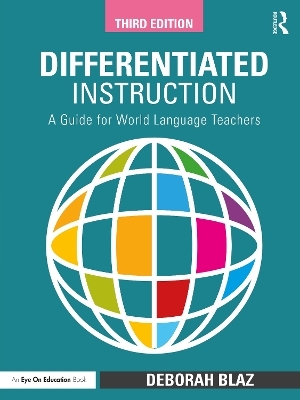
Differentiated Instruction
Routledge (Verlag)
978-1-032-25828-7 (ISBN)
Features new to this edition include:
activities aligned with the latest ACTFL and CEFR standards
ideas and activities for project-based learning, virtual learning, and learning with digital tools, such as ChatGPT
up-to-date latest guidance on learning styles and using variety in teaching
more photocopiable forms, checklists, and handouts for suggested activities
You’ll also learn how to differentiate assessment effectively to help all students show their full potential. Classroom-ready tools and templates can be downloaded as free support material from our website (www.routledge.com/9781032258287) for immediate use.
Deborah Blaz has taught French to grades 7 through 12 for the past 44 years in Indiana and has taught dual-credit, AP, and college classes. She also served as the world language department chair at her school until her retirement in June 2023. An award-winning teacher, she frequently presents workshops and keynotes, regionally, nationally, and internationally.
Detailed Contents
Meet the Author
Preface
New to the Third Edition
I. DIFFERENTIATED INSTRUCTION: WHAT IT IS/ WHAT IT ISN’T
What is differentiated instruction?..................................................
Definition…………………………………………………
What differentiation is not……………………………….
Important beliefs and practices……………………………………
Some research to support differentiation………………………….
II. FROM CONTENT TO PROCESS TO PRODUCT
Content, or What to Teach…………………………………………
Process, or How to Practice………………………………………….
Product, or How to Assess…………………………………………
Preparing yourself………………………………………………..
Preparing the students……………………………………………
Management issues and ideas……………………………………
III. PLANNING A DIFFERENTIATED UNIT
Identify what is to be taught (Content…………………………..
Pre-assess students’ needs and capabilities………………………
Choose the form(s) of assessment to use (Product)……………..
Decide on the method of presentation…………………………..
Classroom environment…………………………………………
Select a variety of learning strategies (Process)………………….
Sample units………………………………………………………
IV. IDEAS SMORGASBORD: Vocabulary Study, Speaking and Listening
Low-prep and high-prep activities list…………………………...
Activities listed by proficiency levels…………………………...
Tic-tac-toe for description of people……………………
Vocabulary………………………………………………………
Speaking/Listening………………………………………………
V. Ideas Smorgasbord: Reading
Pre-reading ……………………………………………………….
Reading …………………………………………………………..
Post-reading ………………………………………………………
Post-reading projects……………………………………
List: Everyday Texts…………………………………………….
VI: Ideas Smorgasbord: Writing and Review
Writing……………………………………………………………
Review……………………………………………………………
List: ABCs of Products…………. …………………………….
VII. Differentiated Assessment
Formal and Informal…………………………………………….
Use choice ………………………………………………….……
Use context………………………………………………………
Use variety………………………………………………….……
Managing grades…………………………………………….…..
VIII. Reflections on Differentiation
Guidelines……………………………………………………..
Graphics…………………………………………………………
Support Systems…………………………………………………..
Frequently Asked Questions and Answers……………………….
APPENDIX A: CHECKLISTS FOR A VARIETY OF PRODUCTS……
APPENDIX B : THE LANGUAGE OF DIFFERENTIATED INSTRUCTION: KEY WORDS AND CONCEPTS……………………………………………….
APPENDIX C: STANDARDS REFERENCED IN THIS BOOK………
Bibliography………………………………………………………………
| Erscheinungsdatum | 16.11.2023 |
|---|---|
| Zusatzinfo | 18 Tables, black and white; 46 Line drawings, black and white; 8 Halftones, black and white; 54 Illustrations, black and white |
| Verlagsort | London |
| Sprache | englisch |
| Maße | 210 x 280 mm |
| Gewicht | 412 g |
| Themenwelt | Schulbuch / Wörterbuch ► Unterrichtsvorbereitung |
| Sozialwissenschaften ► Pädagogik ► Schulpädagogik / Sekundarstufe I+II | |
| ISBN-10 | 1-032-25828-4 / 1032258284 |
| ISBN-13 | 978-1-032-25828-7 / 9781032258287 |
| Zustand | Neuware |
| Informationen gemäß Produktsicherheitsverordnung (GPSR) | |
| Haben Sie eine Frage zum Produkt? |
aus dem Bereich


